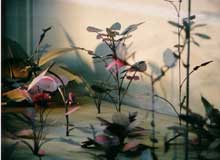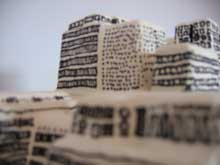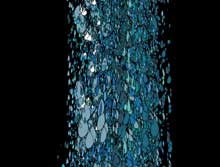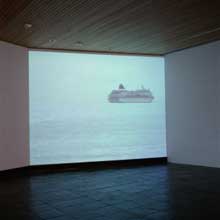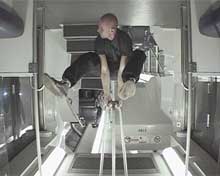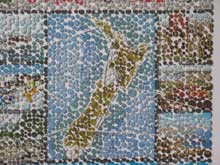 |
|||||||||
|
|
| ...GALLERY EXHIBITS 2005 | ... breathing space: Sally Ann McIntyre | |||||||||||||||||||
|
breathing space Bekah Carran, Regan Gentry, Shaun Gladwell, Maddie Leach, Nathan Thompson, P. Westbourne The Physics Room, 6 th - 30 th April Wandering into a Christchurch winter sans car, my thoughts quickly turn to my umbrella, a svelte and slender creature from the early 20 th century with (if you’ll forgive the fetishist’s attention to minutiae) a long silver pinnacle spike and tooled black crocodile leather handle. Unfurling this wonderfully graceful and culturally loaded object, which is really less a thing than a ‘vehicle’ (in the sense of a transformative spatial possibility) always seems a quiet clarion call to a less utilitarian existence. The appeal of umbrellas has to do with the zone of selfhood they open up, which, due to their embedded sense of near-flaneuristic dalliance, encourages introspective slowness. Functioning as the small roof of an illusory portable room, which nevertheless the body inhabits as though it were a space, an umbrella in rainy weather is an exceptionally comforting ‘breathing space’, whereby, sheltered both from the sight of others and from the wide grey vistas of sublimity that the sky holds, the ‘outside’ is, for a moment, scaled to more intimate, more human dimensions. Under an umbrella there is room and time to stroll about, and to think, and to look at things. It frames the outer world just as it constructs a certain type of contained individuality, a typically elusive sense of personhood, through its delimited solitariness. As such, it arises out of the same post-Enlightenment spectatorship base as the traditional experience of visiting an art gallery, and becomes an exceedingly good, if appropriately digressive, vantage point from which to begin to look at the group show breathing space. breathing space is concerned with ‘leisure and its relationship to the contemporary art gallery’, and from the outset, P Westbourne’s Rain Song declares the show’s focus to be less about ‘easily consumable leisure events’, or products and activities designed as ‘entertainments’ by the monolithic cultural entities of hyper-capitalism, than about how art can function as a zone in which to isolate and frame those ever-diminishing small, private, playful experiences of ‘free time’, and understand them as personally valuable. Recorded in Bergen, “one of the rainiest cities in the world”, Rain Song is an audio work comprised of field recordings of rain hammering against the outer fabric of an umbrella. Situated in the Physics Room’s foyer area, the work literally meets you at the door, and as such functions in the wider context of breathing space as threshold, a sonic sorbet that cleans the sensual palette of everyday assumptions about the ways in which artworks, spectators, and bodies inhabit space. The work is deceptively simple, and in playing back an extended moment of the everyday, which would normally flow by us as unrecorded sonic blind-spot, the sensual properties of that moment are vividly transferred. To stand underneath the cone speaker, substituted here for the umbrella’s improvisational ‘drum skin’, is to be aware of how much of our embodied experience is linked to audibility, as the ‘spectatorship’ of such a work becomes as much to do with the skin prickling on your arms as small hairs stand on end, and with the relaxing of your stomach muscles in response to the inherently comforting reverberations of rain, as it does the experience of seeing. The situating of a sound work in a group show comprised mainly of visual work, is in itself a pointer to a more fluid apprehension of art’s placing, as sound is inherently uncontainable by walls, and as such will influence the viewer’s experience of other works. Walking, then, into breathing space, other free time activities which emphasise solitary space and patience rather than collective consumption and instant gratification are encountered, including the jigsaw puzzle (a more indoor ‘rainy day’ activity), referenced in Regan Gentry’s Re-jigged, although here, instead of fitting together seamlessly, the bright touristic optimism of a New Zealand “teatowel” style map is atomised to a kind of join the dots exercise which will never be finished. The experience of looking out the window becomes a dreaming reverie of transformative and mutative potential in Bekah Carran’s view from my window, in which, much like the forests invading the boy protagonist’s bedroom in seminal children’s story Where the Wild Things Are, the vegetation of the ‘outside’ permeates ‘inside’. Carran’s strikingly crafted urban weeds creep through the floorboards to investigate ideas about the hardiness of city sensibilities, the crossover of the fine arts and street art, and the permeation of the gallery space’s sterile enclosures with ‘viral’ narratives. Shaun Gladwell’s Tangara is a videoed performance of pure play, which pictures the artist in a public tram, hanging upside down on a railing. The image is inverted to suggest anti-gravity, expressing a wish to invert the assumptions we, as spectators, bring to everyday physical phenomena. Tangara also exposes the science fiction films and novels it references as fantasies of escape which, even when enacted with no resources, still transform space in the richness of the human imagination. Maddie Leach’s The Lilac Ship is similarly lo-fi in its visual depiction of a large ocean liner setting off on a voyage, connoting the social and private spaces enabled by ship travel, and the slowness and sublimity of seaward staring eyes. Projected onto the wall, its frame becomes a portal through the gallery space and out into the drift of imaginings both romantic and banal. Gentry’s Takeaways suggests that the activity par excellence of contemplative solitude is, of course, the museum or art gallery visit. A factory line of plaster-of-paris heads, cast from the artist’s own, wait quietly in line for their turn on a pedestal which, instead of elevating them into a museological permanence, will slowly turn them, via a sheet of sandpaper connected to a mechanism, into a pile of white dust. Deconstructing the classical bust, and also the modernist myth of the artist as ‘genius’, Gentry’s time-based installation also, quite wonderfully, seems to pastiche later histories of violent anti-establishment and self destructive gestures by (male) artists, with its inherent gentle politeness. Nathan Thompson’s Busytown is based on the artist’s apprehensions of the dislocating experience of moving to the big city, and as such, initially seems to form a counterexample to the intimate scale of the other works in breathing space. But on closer inspection, it is evident that the models made to represent the city are small in scale, clunkily made, with banks of flashing L.E.Ds glimmering sequinlike from their cardboard facades. The work evokes city wandering, spectatorship and dislocation, and the non-abject melancholy of the flaneur. Sound and image combine to produce phantasmagoric intimations of b-grade and early film, and long gaps in both sound and image play with the audience’s expectations of ‘entertainment’, ushering in the by-now familiar concepts of patience, solitude, open-endedness, the onus on personal response, and the inversion of expected experience, which are true of the show as a whole. Sally Ann McIntyre breathing space Press release, April 2005 Essay also appeared in Presto, May 2005
|
|||||||||||||||||||
